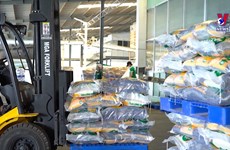Effective seaport use to drive economy upwards
On October 22, 2018, on behalf of the Party Central Committee, Party General Secretary Nguyen Phu Trong signed Resolution 36 on the strategy for the sustainable development of Vietnam’s marine economy by 2030 with a vision to 2045, which sets out numerous tasks for marine economic growth, including developing seaports.
Once seaports are properly linked to other transport networks and support services, the former’s potential can be unlocked.
Seaports are key gateways for import and export activities and seaports and port logistic services are crucial for trade and transport.
Vietnam is now home to 44 seaports and 263 harbours, with several deep-water seaports in operation in the northern and southern regions and others expected to be built in the central region. As seaports can handle 570 million tonnes a year, some 90 percent of imported and exported items receive clearance every year, greatly facilitating the country’s economic growth.
Vietnam’s seaport system planning to 2020 and vision to 2030 divides 45 local seaports into six categories. Two international gateways are now ranked Class 1A, 12 regional focal ports first-class, 18 local focal ports second-class, and 13 offshore oil and gas ports third-class.
Prior to 2007, Vietnamese ports and especially its harbours were infamous for their inferior quality.
Since then, however, the country’s seaports have improved significantly, marked by Cai Mep International Port in southern Ba Ria-Vung Tau province welcoming a container vessel with a cargo capacity of 18,300 twenty-foot equivalent units (TEUs) (or 194,000 deadweight tons) in October.
Seaport development has also caught the attention of the private sector. Multiple global port operators and major shipping lines have now exploited seaports in Quang Ninh province, Hai Phong city, Ho Chi Minh City, and Ba Ria-Vung Tau province.
Vietnam’s seaport development remains on track and is staying abreast of the country’s economic growth.
Prime Minister Nguyen Xuan Phuc recently issued a directive requesting the implementation of measures for effectively connecting transport infrastructure and lowering logistic costs, which now account for an average of 21 percent of a product’s price, which is very high compared to developed countries.
Logistics now account for 3 to 4 percent of GDP and post a rapid growth rate of 15 to 20 percent each year. The sector is expected to contribute 8 to 10 percent of GDP by 2025 thanks to lessons learned from logistics practices in developed countries.
According to Vietnam’s seaport system development plan, the country is looking to give custom clearance to 640 billion tonnes of goods in 2020 and 1.1 billion tonnes in 2030./.











